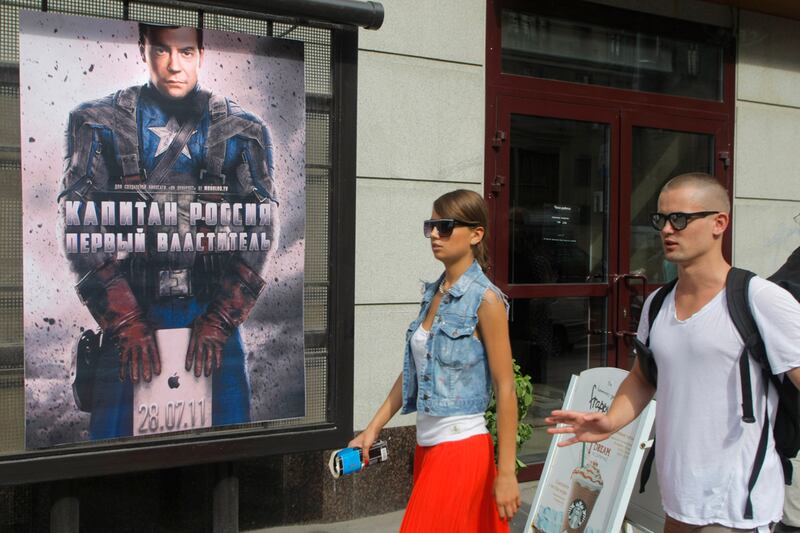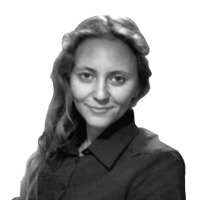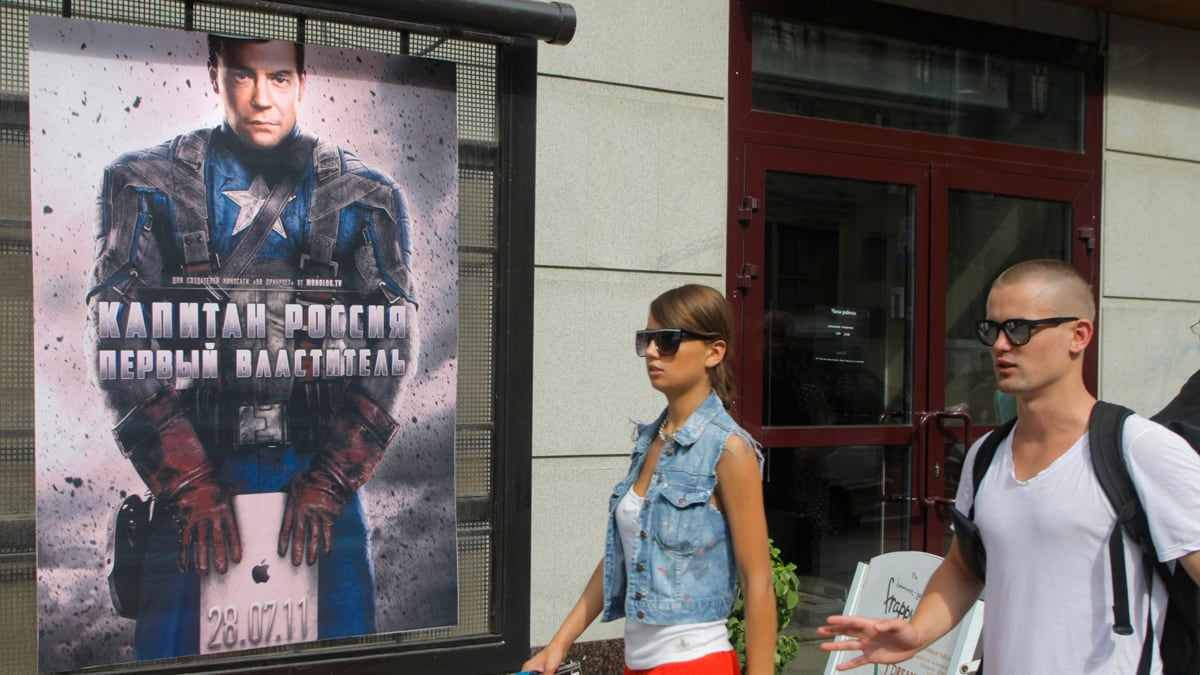They do it in the dark, while the city is sleeping. Moscow’s streets are empty of pedestrians and traffic; it’s too late for policemen and too early for the street sweepers. At this nocturnal hour, artists from a mysterious group called Monolog Art unfurl their posters on bus stops, shadowy boulevard walls, and even on big billboards right beside the Kremlin. The first series of posters appeared a month ago, featuring Prime Minister Vladimir Putin with feminine shaved legs and a laurel wreath forming the letter P on his T-shirt. Beside him, President Dmitry Medvedev fondled a squash racket. Both were suntanned and wore white tennis shorts, standing shoulder-to-shoulder and smiling in a kinky way. “New collection Spring-Summer 2011,” the poster said.
The morning after the first poster attack, the Moscow mayor’s office ordered workers to tear down the works, calling them “acts of hooliganism.” But before the perpetrators could be found and arrested, more amusing posters appeared on the streets: Medvedev—the technology-loving leader who promised a reset with the West—in a Captain America outfit, brandishing an iPad instead of a shield. On his chest, a sign announced, “Captain Russia. The First Ruler.”
Monolog’s artists prefer not to identify themselves, since anti-government “hooliganism” can easily be punished with a few months of detention or even a few years in prison. But they agreed to speak to The Daily Beast about their antics. “Everybody urinates in their pants before these two [leaders],” said one of the artists, “but it is so stupid to be afraid of these people. They decide everything for us while we ultimately lack any knowledge of their politics.” The artist called the motivation for the group’s poster series as “opposition to forced stereotypes.”
Monolog is not the only dissident street art group ramping up its activity, particularly in the run-up to presidential elections, now less than a year away. From Moscow to deepest Siberia, subversive artists are provoking the powers-that-be. On the Eastern side of the Ural Mountains, in Yekaterinburg, a street artist named Slava created a multi-layered mosaic of Putin’s face on a city wall, which was designed to be disassembled piece-by-piece. Pedestrians could take a chunk of the mosaic off of a nail and bring it home, or move it onto a mosaic of President Medvedev’s face. As onlookers peeled off the layers, the art pieces transformed from skin to facial muscles, and finally to a bare wooden board with the message “Hello Suckers.” Slava had pinned a description of his concept next to the piece: “Putin holds enormous power over Russian people; millions of minds, bodies and souls. The time for the revenge has come; tear off a piece of the God.” The city enjoyed the art game for a couple of days before the Yekaterinburg municipal services hurried to remove the remains of the mosaics out of sight.

Nearby, in the central Russian city of Izhevsk, a group of graffiti artists calling itself the Ministry of Street Artists has created a series of posters called “President 2012,” showing images of a post-apocalyptic battle between Putin and Medvedev. In Perm, Russia’s fast-developing capital of contemporary art, the Red People art installation featured enormous square sculptures of identical red men sitting on the roofs of state buildings. The artwork offended local bureaucrats, who complained to the governor. “We received various notifications from Perm deputies blaming us for making fun of the United Russia ruling party members,” says Marat Gelman, art curator and promoter of Perm’s art festivals and street installations. “But it is too late to try and suppress the bursting freedom of art expression.”
The growing street art movement in Russia has been heavily inspired by the Western street artist Banksy—who has managed to keep his real identity concealed—and by Voina (“War”), an underground Russian art collective that has engaged in radical street art action. Voina shot to fame after filming an orgy in the Moscow state biological museum three days after the 2008 presidential election, to protest “elections turned into a pornographic act.” In another performance, the group turned a police car upside down in the Palace Revolution Square in St. Petersburg (Palace Coup). Though two of the group’s leaders were put on trial last spring for hooliganism—they were ultimately released on bail—Russia’s Ministry of Culture nevertheless decided to award Voina the prestigious Innovative Prize for Visual Art for their piece titled Dick Captured by FSB. The installation—a 60-foot-long phallus painted on a cantilevered bridge in Saint Petersburg that rose erect when the bridge opened in the middle of the night—could be seen from the headquarters of the Federal Security Service, the successors to the KGB and persecutors of Voina’s ringleaders. “Unlike the secret police, the jury from the ministry of culture had a great sense of humor,” says popular satirist and playwright Victor Shenderovich, a fan of Voina’s work.
But as elections approach, the Russian authorities are unlikely to show a sense of humor or leniency toward the renegade artists. Last winter, police raided four modern art studios in an apartment building a block from the Kremlin. One of the building’s residents, Gosha Ostretsov—who created a series of pieces titled Criminal Government, Sleeping Government featuring jailed or slumbering men in masks with bloody hands—said that he and a dozen other artists were forced out of their rented studios by men in uniforms and black balaclavas. The authorities also confiscated the private computers and art pieces of the PG art group, a Deutsche Bank-sponsored winner of the Kandinsky Prize. “Unfortunately, nothing has changed since the KGB terrorized artists in the 1980s,” says Ostretsov. Artist Lesha Kalima—who once drew a circle around the Kremlin with cockroach poison—agrees: “A decade ago, artists expected things would grow dark again. Now we urge people to wake up and think.”





